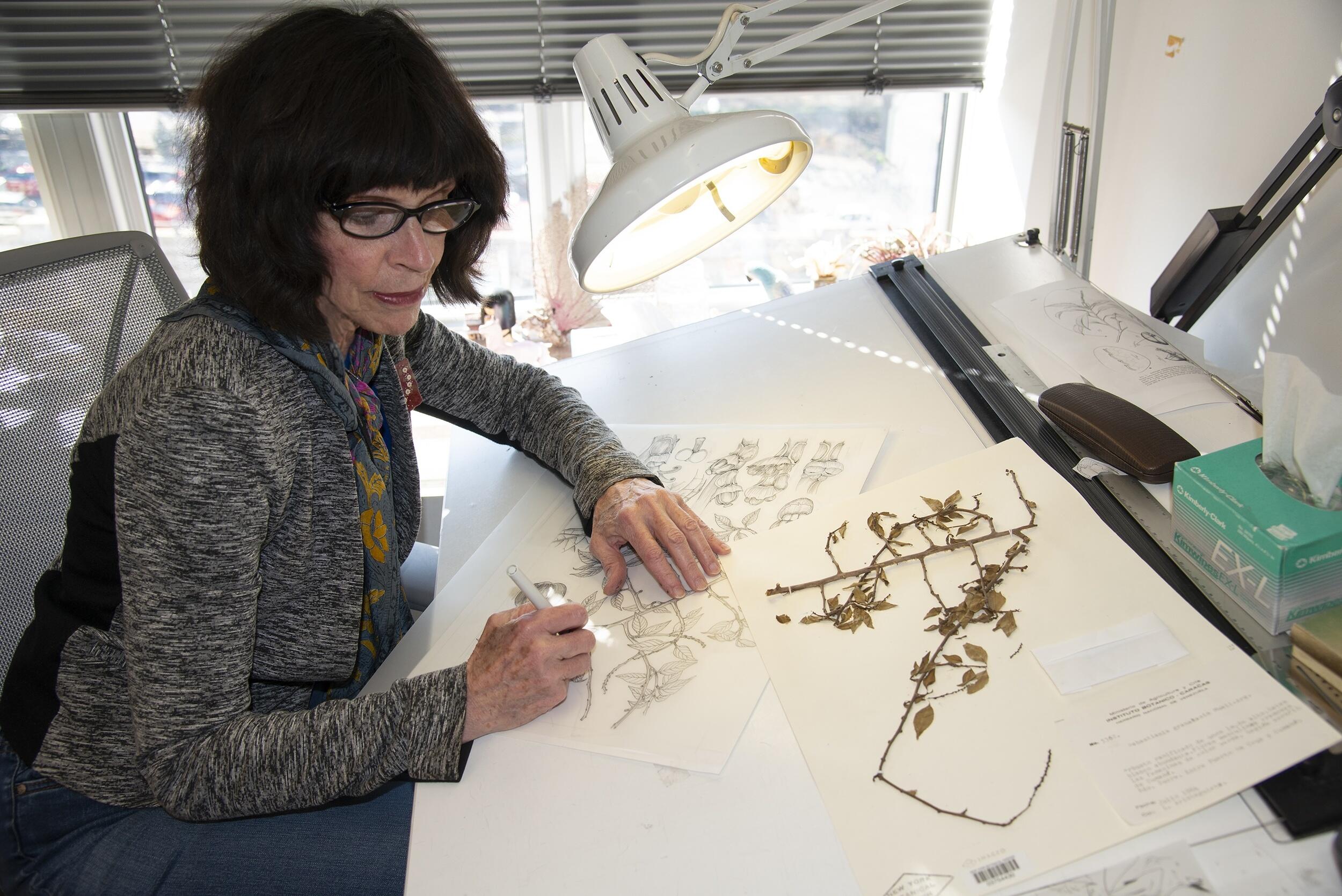
July 17, 2024
The artistry of Alice Tangerini has deep roots at the National Museum of Natural History
Share this story
When Alice Tangerini graduated from Virginia Commonwealth University in 1972, she already had a job as the first and only botanical illustrator at the National Museum of Natural History.
More than 50 years later, she’s still at it – and still the only staff botanical illustrator that the museum, on the National Mall in Washington, has ever had.
Tangerini started as a contract illustrator for the museum while she attended Montgomery College in Rockville, Maryland. A neighbor had suggested she apply to create illustrations for Lyman Smith, Ph.D., the distinguished leader of the Smithsonian Institution’s botany department.
“At the time, my portfolio consisted of horse and dog drawings in pen and ink, and upon showing them to Dr. Smith, he inquired about any plants to show,” Tangerini said. “I remember pointing to the grass under the horses’ hooves, and Lyman replied, ‘Come on down to the museum and I will give you a try.’ That was the beginning of my career.”
But Tangerini’s passion goes back further. The illustrator has been drawing since she was at least 4 years old.
“I remember, in kindergarten, I never wanted to color in those mimeograph pictures we were given to color,” she said. “I wanted to draw my own pictures.”

Tangerini kept drawing throughout her youth, and she earned an associate degree in art in 1970 from Montgomery College. She then came to VCU to earn her bachelor’s degree in painting and printmaking from the School of the Arts.
Tangerini had no specific training beyond an evening botany course at Montgomery College. She mostly learned on the job from highly trained scientists – and continues to do so.
A typical day sees Tangerini in her office, where she creates drawings for botanical journals and books using traditional tools such as pens, ink and graphite, as well as digital tools in Adobe Photoshop.
“I work on demand from the botanists’ requests, which can be for new species, monographs or floras, and I also manage and curate our collection of botanical art in the museum,” she said.
But the job does take Tangerini into the field on occasion.
“The trips are only a couple of weeks at a time but very intense, as certain species are supposed to be illustrated while I am on travel,” she said. “Even on these trips, I only work for a short time in the field. Mostly I am in labs — especially if details of the specimens need to be drawn.”
Some of Tangerini’s travels have been particularly memorable. In 1992, she visited Guyana to draw illustrations for a checklist of the South American country’s native plants. But the government would not issue permits for collecting samples, so she spent a few days in a tropical plant farm drawing whatever was in bloom or suggested by the botanists there.
“At that time, Georgetown, Guyana, had limited hours of electricity, so I spent my last evening drawing a Heliconia inflorescence by headlamp, which the next day was presented to the prime minister,” she said.
Tangerini’s job also has taken her to Hawaii twice: to Oahu in the mid-1990s and Kauai in the mid-2000s. In Oahu, she worked at the Lyon Arboretum drawing Zingiberales species for museum botanist John Kress. It was during El Nino, and it rained more than 35 inches a week.
“I drew in the field then wearing a raincoat and sometimes under a big plastic tarp to protect the drawings,” Tangerini said. “Fortunately there was a lab station where I would spend time drawing flowers under a microscope in the evening.”

She often has had to draw plants while relying on very limited resources. In 2021, she received a standard-size envelope containing a single sprig with two leaves and tiny flowers from a new species of Hawaiian Schiedea. She managed to make a full-size drawing of the entire plant with the help of some digital photographs, and she added color digitally to the pen and ink drawing. Her museum botanist colleague, Warren Wagner, was pleased with the results.
Tangerini said she is grateful for the volunteers and interns who have supported her work – and the opportunity to have taught classes while learning from other scientific illustrators. And even after a half-century on the job, she has no plans to retire anytime soon. She said she enjoys drawing and managing the inventory of botanical art too much.
“My job is very rewarding, as it uses my expertise in drawing, and my work is much appreciated by my department,” Tangerini said. “Every plant presents a new challenge and a desire to improve skills in showing the plant specimens.”
Subscribe to VCU News
Subscribe to VCU News at newsletter.vcu.edu and receive a selection of stories, videos, photos, news clips and event listings in your inbox.




